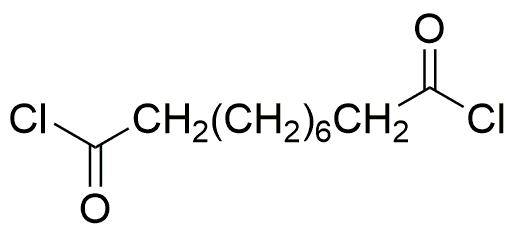Sebacoyl chloride is widely utilized in research focused on:
- Polymer Production: It serves as a key intermediate in the synthesis of polyamides and polyesters, which are used in various applications from textiles to automotive parts.
- Pharmaceutical Manufacturing: This compound is used in the production of certain drug formulations, enhancing the solubility and stability of active ingredients, which is crucial for effective medication delivery.
- Surface Coatings: Sebacoyl chloride is employed in creating specialty coatings that provide corrosion resistance and improved durability for metal and plastic surfaces.
- Adhesives and Sealants: Its reactivity allows for the formulation of strong adhesives and sealants, which are essential in construction and automotive industries for bonding materials.
- Research and Development: In laboratories, it is used for synthesizing various chemical compounds, aiding researchers in developing new materials with tailored properties.
General Information
Properties
Safety and Regulations
Applications
Sebacoyl chloride is widely utilized in research focused on:
- Polymer Production: It serves as a key intermediate in the synthesis of polyamides and polyesters, which are used in various applications from textiles to automotive parts.
- Pharmaceutical Manufacturing: This compound is used in the production of certain drug formulations, enhancing the solubility and stability of active ingredients, which is crucial for effective medication delivery.
- Surface Coatings: Sebacoyl chloride is employed in creating specialty coatings that provide corrosion resistance and improved durability for metal and plastic surfaces.
- Adhesives and Sealants: Its reactivity allows for the formulation of strong adhesives and sealants, which are essential in construction and automotive industries for bonding materials.
- Research and Development: In laboratories, it is used for synthesizing various chemical compounds, aiding researchers in developing new materials with tailored properties.
Documents
Safety Data Sheets (SDS)
The SDS provides comprehensive safety information on handling, storage, and disposal of the product.
Product Specification (PS)
The PS provides a comprehensive breakdown of the product’s properties, including chemical composition, physical state, purity, and storage requirements. It also details acceptable quality ranges and the product's intended applications.
Certificates of Analysis (COA)
Search for Certificates of Analysis (COA) by entering the products Lot Number. Lot and Batch Numbers can be found on a product’s label following the words ‘Lot’ or ‘Batch’.
*Catalog Number
*Lot Number
Certificates Of Origin (COO)
This COO confirms the country where the product was manufactured, and also details the materials and components used in it and whether it is derived from natural, synthetic, or other specific sources. This certificate may be required for customs, trade, and regulatory compliance.
*Catalog Number
*Lot Number
Safety Data Sheets (SDS)
The SDS provides comprehensive safety information on handling, storage, and disposal of the product.
DownloadProduct Specification (PS)
The PS provides a comprehensive breakdown of the product’s properties, including chemical composition, physical state, purity, and storage requirements. It also details acceptable quality ranges and the product's intended applications.
DownloadCertificates of Analysis (COA)
Search for Certificates of Analysis (COA) by entering the products Lot Number. Lot and Batch Numbers can be found on a product’s label following the words ‘Lot’ or ‘Batch’.
*Catalog Number
*Lot Number
Certificates Of Origin (COO)
This COO confirms the country where the product was manufactured, and also details the materials and components used in it and whether it is derived from natural, synthetic, or other specific sources. This certificate may be required for customs, trade, and regulatory compliance.


